Debunking Osteoporosis Myths

UMass Memorial Health is debunking myths about osteoporosis. Unlike mammograms and colonoscopies, osteoporosis and bone density tests don’t get as much airtime or visibility. As a result, we’ve heard myths about the disease and screenings, and we want to set the record straight. Myth: I don’t have any risk factors, so I don’t need to be screened. You may think you don’t have any risk factors for osteoporosis, but in addition to the ones below, there are other diseases, medications and procedures that contribute to your bones weakening. Common risk factors:
- Rheumatoid arthritis
- Smoking
- Excessive alcohol
- Eating disorders
- Premature menopause
- Calcium disorders
- Vitamin D deficiency
- Diabetes
Myth: I feel healthy and I’m active, so I probably don’t need a screening. Osteoporosis is called a silent disease because you don’t know that your bones are weakening. Sometimes a broken bone will trigger the diagnosis. Testing is recommended for:
- Postmenopausal women under age 65 who have one or more additional risk factors for osteoporosis (other than menopause)
- Women ages 65 and older regardless of additional risk factors
- Men over the age of 70 (check on insurance coverage)
- Adults who have a low-impact fracture
- Women who are considering therapy for osteoporosis if testing would change the decision
- Women and men on high-risk medications, such as glucocorticoid therapy or aromatase inhibitors
- Diseases, conditions and medications associated with low bone mass or bone loss
Myth: Osteoporosis is cancer of the bones. Osteoporosis isn’t cancer. Osteoporosis, one of the most common conditions affecting bone health, causes the bones to become thinner and weaker increasing the chances for a fracture. Bones in the hip, wrist and spine are particularly at risk for fractures due to osteoporosis.

Myth: My doctor hasn’t spoken to me about bone density screening or osteoporosis, so I don’t need to be worried. Talk to your doctor at your next appointment or give their office a call and ask. If left unrecognized and/or untreated, osteoporosis can lead to fractures, often requiring surgery, long-term rehabilitation and/or nursing care, and loss of function and independence. Additionally, twenty percent of seniors who break a hip die within one year from either complications related to the broken bone itself or the surgery to repair it. However, in addition to treatment for underlying conditions, many medications are now available that can stabilize and increase declining bone density and reduce fracture risk. Learn more about osteoporosis and testing.
Myth: Osteoporosis is a woman’s disease. Although women are four times more likely to develop osteoporosis, it also affects men. Put another way, about 54 million Americans have osteoporosis and low bone mass, placing them at increased risk for osteoporosis. Studies suggest that approximately one in two women and up to one in four men aged 50 and older will break a bone due to osteoporosis.
Myth: The screening for osteoporosis isn’t as easy as it seems. The bone density test is quick and painless and performed on a bone densitometer machine. It’s very similar to having an X-ray performed while lying down. Most of the time, you keep your street clothes on during the test. Sometimes, you may be asked to wear a hospital gown. It takes about 30 minutes. Also called dual-energy X-ray absorptiometry (DXA), or DEXA scan, the bone density test measures the thickness and strength of bones in your spine and hips. By looking at the results and risk factors, your risk for fracture can be determined.
Myth: I’ll get too much radiation when I’m screened. This quick and painless test is very similar to having an X-ray performed while lying down. While radiation is involved, the amounts are less than a mammogram.
Myth: I’ve had a negative scan, so I don’t need another one. Even though you’ve had a negative screening, talk to your doctor about follow-up screenings. Testing frequency varies according to your risk factors and history, which can change over time. Related: 4 Ways to Better Bone Health 5 Steps to Avoid Osteoporosis

